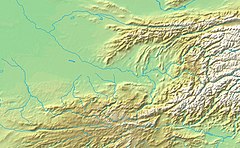| Penjikent murals | |
|---|---|
 Penjikent mural in the Hermitage Museum, Saint Petersburg. | |
| Created | 5th century - 722 CE |
| Discovered | Panjakent, Tajikistan 39°29′12″N 67°37′14″E / 39.486792°N 67.620477°E |
| Present location | Hermitage Museum, National Museum of Antiquities of Tajikistan |
| Culture | Sogdian |
The murals of Penjikent are among the most famous murals of the pre-Islamic period in Panjakent, ancient Sogdiana, in Tajikistan. Numerous murals were recovered from the site, and many of them are now on display in the Hermitage Museum in Saint Petersburg, and in the National Museum of Antiquities of Tajikistan in Dushanbe. The murals reveal the cosmopolitan nature of the Penjikent society that was mainly composed of Sogdian and Turkic elites and likely other foreign merchant groups of heterogeneous origin.[1] Significant similarities with Old Turkic clothing, weapon items, hairstyles and ritual cups are noted by comparative research.[2]
The murals of Penjikent are the earliest known Sogdian murals, starting from the late 5th to early 6th century CE, and are preceded by the Hepthalite murals of Tukharistan as seen in Balalyk Tepe, from which they received iconographical and stylistic influence.[3] Also visible is a great variety of Hellenistic influences of Greek decorative styles along with local Zoroastrian, Christian, Buddhist and Indic cults.[citation needed]
The production of paintings started in the end of the 5th century CE and stopped in 722 CE with the invasion of the Abbasid Caliphate, in the Muslim conquest of Transoxiana, and many works of art were damaged or destroyed at that time.[4][5][6]
- ^ The Sogdians: Influencers on the Silk Roads, The City of Panjikent and Sogdian Town-Planning by Alexander Brey. Smithsonian Institution.
- ^ Ermolenko L.N., Soloviev A.I., Kurmankulov Z.K. An Old Turkic Statue at Borili, Ulytau Hills, Central Kazakhstan: Cultural Realia. Archaeology, Ethnology & Anthropology of Eurasia. 2016;44(4):102-113. https://doi.org/10.17746/1563-0110.2016.44.4.102-113
- ^ Azarpay, Guitty; Belenickij, Aleksandr M.; Maršak, Boris Il'ič; Dresden, Mark J. (January 1981). Sogdian Painting: The Pictorial Epic in Oriental Art. University of California Press. p. 93. ISBN 978-0-520-03765-6.
- ^ "PANJIKANT – Encyclopaedia Iranica". iranicaonline.org.
- ^ Compareti, Matteo (2012). "Classical elements in Sogdian art: Aesop's fables represented in the mural paintings at Penjikent". Iranica Antiqua. XLVII: 303–316.
- ^ Guides, Insight (April 2017). Insight Guides Silk Road (Travel Guide eBook). Apa Publications (UK) Limited. p. 521. ISBN 978-1-78671-699-6.
© MMXXIII Rich X Search. We shall prevail. All rights reserved. Rich X Search



